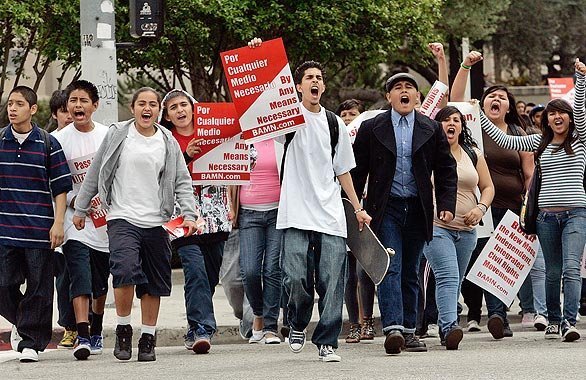Youth Declaration for a New Civil Rights Movement

1. We call for a new, mass, independent, integrated civil rights movement to fight for equal, quality education for all, including the defense of affirmative action and integration.
2. The history of the past struggle for equality is a history of brave struggles by youth for their own futures. In the spring of 1963, the defiant courage of black teenage youth in Birmingham, Alabama made victory possible in the campaign led by Martin Luther King that set the stage for the great August 1963 March on Washington. Over and over throughout the 1960s, black and other antiracist teenage and younger youth were the often unsung heroes of the movements for equality and justice.
3. Despite the decisive role youth played in making it possible for the past movements to win victories, senior movement leaders did not usually recognize youth as leaders in their own right. Youth were usually not included when leaders met to make key decisions. This failure inevitably contributed to the limitation of the gains won by these movements and the fact that now so many of those gains have been reversed or are under attack.
4. As the people whose future is most at stake, high-school and middle-school youth will be at the forefront of any new movement for equal educational opportunities.
5. For this new civil rights movement to win, youth will also have to be recognized and respected as part of the leadership of the movement and be included in democratic discussion of the development of the movement’s policies, tactics, and strategy.
6. For victory to be possible, the character of the new civil rights movement will have to be determined by the boldness and idealism of the youth, not the cynicism and despair of a tired-out older generation.
7. In our schools, we are victims of all the inequalities and discrimination of American society as well as overcrowded classes, under funded programs, and inadequate facilities. Middle-school and high-school students also have to deal with the problems of being disrespected by adults and fears of the curiosity, creativity, and sexuality of young women and men. As part of the new movement, youth will lead struggles in their schools for equal, quality education for all; for student rights; and for the dignity of youth.
8. Children and youth are the most vulnerable victims of poverty, inequality, and discrimination. Teenagers and older youth are the main victims of police profiling, harassment, and brutality. Youth fighting for their rights in schools will also become leaders of struggles for justice in their communities.
9. Young women and men will be fully equal, mutually respected partners in building the new movement.
10. In the new movement, black, Latina/o, Arab, Asian, other minority, and white youth will unite in an integrated, intransigent fight against racism and all forms of bigotry and discrimination. The new movement will also break down the divisions between inner-city and suburban and rural schools in a common struggle for improved education for all.
11. With a relentless desire to stand on the truth, the youth activists of the new civil rights movement will reject the lies and hypocrisy of an older generation of politicians and sellout leaders.
12. We declare our commitment to build and lead the fight for our own futures by whatever methods are necessary in order to win. We will not sell out, and we will not give up.
